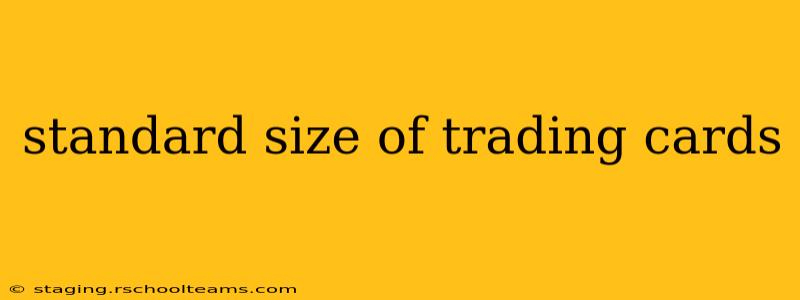Trading cards, those small rectangles of cardboard holding immense value and nostalgia, come in a variety of sizes. However, there's a standard that most collectors and manufacturers adhere to, making it easier to store, organize, and display these collectibles. This guide will delve into the standard size, variations you might encounter, and the reasons behind these dimensions.
What is the standard size of a trading card?
The most common and widely accepted standard size for trading cards is 2.5 inches wide by 3.5 inches tall (63.5 mm x 88.9 mm). This size has been prevalent for decades, becoming the de facto standard for sports cards, Pokémon cards, Magic: The Gathering cards, and countless others. This consistent sizing allows for easy storage in binders, boxes, and sleeves, promoting organization and protection of valuable cards.
Why this specific size?
The precise origins of the 2.5" x 3.5" standard are somewhat murky, lost to the mists of time and early card manufacturing. However, it's likely a combination of factors:
- Practicality: This size is large enough to showcase imagery and text clearly but small enough to be easily handled and stored in large quantities.
- Production Efficiency: A standardized size simplifies the manufacturing process, making mass production more cost-effective and efficient.
- Industry Standard: Over time, this size became the accepted norm, with most manufacturers adopting it to maintain compatibility and meet collector expectations.
Are there any variations in trading card sizes?
While 2.5" x 3.5" is the dominant standard, you might encounter slight variations:
- Minor Manufacturing Differences: Due to the printing and cutting processes, individual cards can have minor discrepancies in size, typically within a fraction of a millimeter. These minor inconsistencies are usually insignificant.
- Oversized Cards: Some high-end or promotional cards might be slightly larger, often as a premium feature.
- Non-Standard Cards: Some card games or collectible sets might deviate from the standard, introducing unique sizes for aesthetic or gameplay reasons. Examples include oversized cards for promotional purposes or cards with unusual shapes.
What about different types of trading cards? Do they all follow the standard?
Most major trading card manufacturers and games, such as those mentioned above (sports cards, Pokémon, Magic: The Gathering), generally adhere to the 2.5" x 3.5" standard. This ensures compatibility across various products and accessories. However, as mentioned above, exceptions exist for promotional or specialty cards.
How do I know if my cards are standard size?
The easiest way to determine if your trading cards are standard size is to simply measure them using a ruler. If the dimensions are close to 2.5 inches by 3.5 inches, then they conform to the common standard.
What are the benefits of standardized trading card sizes?
Standardization offers significant advantages:
- Easy Storage and Organization: Standard-sized cards fit perfectly into sleeves, binders, and boxes, simplifying organization and protection.
- Compatibility with Accessories: Protective sleeves, toploaders, and other accessories are designed to fit standard-sized cards.
- Collectibility and Trading: A consistent size facilitates trading and collecting, as buyers and sellers know what to expect in terms of dimensions and compatibility.
In conclusion, while minor variations exist, the standard size of trading cards remains a crucial aspect of the hobby, impacting storage, organization, and the overall experience for collectors and players alike. The 2.5" x 3.5" dimension is a testament to the efficient and practical design that has stood the test of time within the vibrant world of trading cards.
